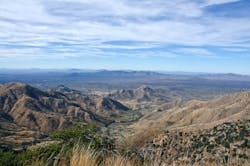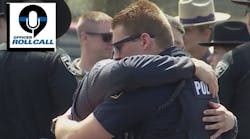On Aug. 27, 2020, Tohono O`odham Nation Police Officer Bryan Brown was killed as he and other officers responded to reports of an armed man driving erratically near the Desert Diamond Why Casino at night. As Brown arrived at the scene, the man approached him while holding a broken bottle before getting into the officer’s patrol vehicle, stealing it and intentionally ramming a Border Patrol vehicle. The man then accelerated toward Brown, who was able to shoot the suspect before being struck. The man, who later told investigators he was high on meth, was arrested after a pursuit and charged with murder and three counts of assaulting a federal officer.
“My job is to make sure that I don’t see that, at least in my lifetime, ever happen again,” says Elton Begay, who just completed his third year as chief of police of the large Indian nation in Arizona. “Not only in this agency, but I’d hate to see another tribal law enforcement agency or other agencies go through that.”
Policing Indian reservations remains a mystery for those who don’t live on or near tribal land, but for those officers tasked with patrolling the vast swathes of land, there are enormous challenges they must face. During a discussion hosted by the National Law Enforcement Memorial and Museum focused on officer safety and wellness on tribal lands, police chiefs from tribal agencies of varying sizes met to share their insights.
Response times
Officers who serve on the approximately 326 reservations in the U.S. can drive 45 minutes or more to a call with backup more than an hour away, making the risk more dire than most urban and suburban agencies could imagine.
“There are many unique challenges that we face for tribal law enforcement in Maine, such as the issue of relying on backup, which in some instances is many miles away,” says Penobscot Nation Police Chief Robert Bryant, who has spent the past 14 years as chief. “This mutual aid is not always consistent and in some cases it doesn’t show up.”
The Tohono O`odham Nation is comprised of about 4200 square miles and shares about 62 miles with Mexico.
“We spend a majority of our time now responding to border-related issues, so when it comes to those true 911 calls for service, a lot of our time is just traveling to make sure we get there,” Begay says.
Meskwaki Nation Police Chief Jacob Molitor heads the only tribal police department in Iowa which patrols a reservation of roughly 12 square miles.
“We’re really having to communicate what Indian Country law enforcement is. Until the end of 2018, we were treated like a Public Law 280 state. Basically, we were all like state officers. We had that law repealed, and now we are in need of special law enforcement commissions which we applied for but have not yet received to be able to file federal charges when applicable,” says Molitor, who also serves the chair of the Board of Governors of the Small and Rural Law Enforcement Executives Association. “We used to have mutual aid agreements with our surrounding agencies. We have decent relationships, but we are still to the point where we don’t have them.”
Mental health and wellness
Maintaining healthy eating habits and fitness goals can be difficult for any law enforcement officer, but for tribal officers, that difficulty is increased by both geography and the availability of places to eat and workout. Begay says the Tohono O`odham Nation doesn’t have a restaurant on every corner and there is only one grocery store on the reservation that is nearly the size of the state of Connecticut. Added to that is the drive times. Officers spend 10 hours on a shift, but going to and from their post can take up to three additional hours. “By the time you’re home, you are gone. You’re spent. You don’t want to go to the local gym.”
With this challenge in mind, the Tohono O`odham Nation’s physical fitness and defensive tactics course will now include eating habits and behavioral health. “Being a tribal nation with a high diabetes rate, we want to make sure we’re looking out for the best for all of them and having the longevity to be in this profession,” he says. “We want to make sure that they are healthy, not only for their position, but for themselves and their families.”
Previous to joining the Penobscot Nation, Bryant worked about 14 years in a non-tribal law enforcement agency. “Out of all the death scenes I went to, I didn’t know one person. Working here in the community I live, every scene where I go where somebody has died, or there has been some type of suicide or overdose, you know those people. That affects you more directly than it would if you’re working in a community where you don’t know these people.”
The Meskwaki Nation Police Department began holding Empathy Roundtables. In the exercise, the officers are told to write down on index cards the most important things in their lives. Next, those cards are taken away by their supervisors with an explanation why. Scenarios such as having a loved one die in a crash or losing the person’s home and belongings in a fire can seem real to the participants, allowing them and their colleagues to learn how to deal with difficult emotions surrounding loss.
“Indian people deal with loss all of the time. Dying at young ages, sexual assault, domestic violence, it goes on and on. I used this with my agency, and I was very surprised how well it went,” says Molitor. “A reason I think this works with officer safety and wellness is because it can help us better understand our community and help bring us closer together when we are interacting with people. As a result, we will be safer because they know that we’re interacting with them with the best intentions. We’re trying to help.”
Hiring and retention
All three police chiefs say that attracting and retaining qualified officers is one of the biggest challenges facing tribal law enforcement agencies. They all lack pension programs for retirement and their wages are well below the average for officers in their states.
“Essentially, we have become a training ground a lot of times for other agencies,” Bryant says. “We bring newer officers in, they get trained, after a couple of years they are looking for the best opportunity for themselves and their family and they move on. I have always told my officers, ‘You do what’s best for your family and yourselves.’ ”
Begay says that the salaries offered by the Tohono O`odham Police Department are about 25% less than some of the competitive agencies in Arizona. “Now with the current generation, they see the dollar figure,” he says. To make things worse, there are big metropolitan police departments and large sheriff’s offices nearby that have close to 200 to 400 vacancies. The Tohono O`odham Nation is budgeted for 150 police officers, but currently has only 76 certified officers.
“We’re the only agency (in the state) that doesn’t have a pension system,” Molitor says of the Meskwaki Nation Police Department. “Any officer in the state who has more than a few years on isn’t going to want to give that up and come to us. They’re either going to be retired and come to us, or they’re going to come to us after 1 to 3 years or so where they are not really vested and they have limited experience.”
Molitor says that despite the drawbacks and challenges of leading a police department on an Indian reservation, he is proud to represent the Meskwaki Nation and there is no place he’d rather be.
“Right now, what I’m focusing on is what I can control. There are so many things as a tribe that vary to non-tribal agencies,” he says. “What I think we really have to do is focus on all of the great things about working for a tribal agency and highlighting those and draw in the people who want to be part of that and making it known what is so special about being part of a tribe. Those are the people we want; the people who are going to stay, the people who will buy into our mission and our purpose for helping Indian people.”



